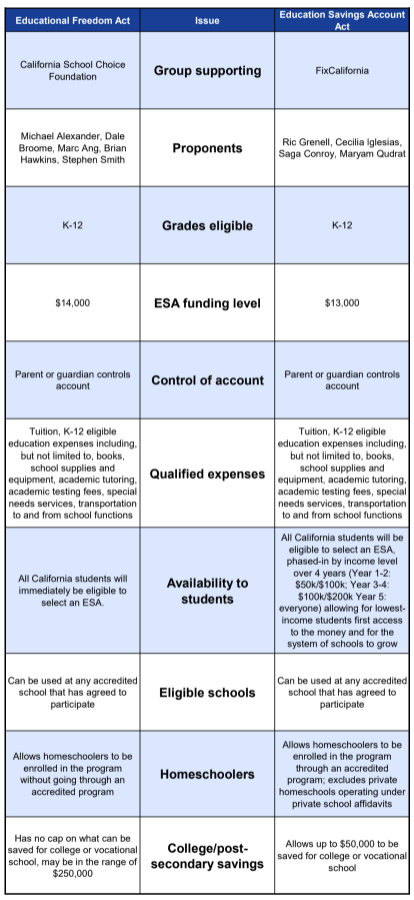Two ballot proposals hold great promise for CA students
Political observers speculated there was just one reason many schools re-opened this fall: teachers union leaders wanted to help Gov. Gavin Newsom, then fighting off a campaign to remove him from office. Were Newsom to win, they argued, California’s teachers unions would have a loyalist in office, allowing teachers unions to work from home, and relegating the state’s K-12 students to distance-learning schemes would have fewer reasons to remain in the classroom and would return to the stance they took for the entirety of the 2020-21 school: it’s just too dangerous to teach face-to-face.
But an apparent curveball has been thrown – two, actually – that could force the hand of the unions. California citizens have submitted two ballot measures to the California Attorney General that, if either gains traction, could ensure in-person instruction remains an option for all students throughout this school year. More importantly, if voters approve one or both of the ballot measures, all California students would have the opportunity and resources to receive a quality education, regardless of their family’s income or the zip code in which they reside.
The two proposed initiatives would both create an extensive Education Savings Account program in the state of California, giving families the ability to pull their students out of public schools and pay for alternative education with money already tied to them in the current system.
Education Savings Accounts (ESA) create parent-controlled accounts that may be used to pay for schooling and other educational expenses and have been growing in popularity in the past decade. They are considered the gold standard of school choice.
If a parent decides the district or neighborhood public school their child has been assigned to isn’t meeting their needs, they may remove them from that school and opt-in to an ESA to fund private schooling, offset homeschooling expenses, cover transportation costs to a charter school, or pay for any other array of educational expenses.
These accounts are funded by the state using a portion of the dollars that would have otherwise been spent educating the child in their public school. Unspent funds roll over in the account every year allowing families to save up for more expensive high school expenses. Money remaining when the student graduates may be used to pay for college, trade school, or other secondary education. Similar to a Health Savings Account, or a Supplemental Nutrition Assistance Program (SNAP) card, ESAs may pay for pre-authorized educational purchases. Non-educational expenses would be rejected, just as a SNAP or HSA card could not be used to buy a new blouse.
As is often the case with California ballot initiatives, more than one effort on the same topic is underway. One, both, or neither could qualify for the November 2022 ballot, and California voters are not limited in which they may support. If the organizers who’ve put forth the initiatives collecting the 997,139 needed signatures for a constitutional amendment, they qualify the proposal for the ballot and it will be put to voters. If both initiatives are successful and make it on the ballot, voters could vote in favor of one, both, or neither proposal. If both initiatives pass, the one receiving the greatest number of votes would be enacted.
So, what are the core features of each proposal, and who is behind them? The first proposal, called the Education Freedom Act, was submitted by the California School Choice Foundation, led by Michael Alexander. The second proposal, known as the Education Savings Account Act, comes from Fix California, led by Richard Grenell. At the core, both proposals are similar: They’d establish the nation’s most comprehensive ESA program, available to all K-12 students in the state. Their key differences stem from how the programs will be rolled out, how ESA funds may be spent, amounts of annual dollars and how much money they may bank over time.
The Educational Freedom Act would allow all K-12 students to immediately enroll in the program and receive $14,000 for the first year, increasing with inflation. The funds could be spent at any accredited school, and homeschooling families could use the funds for educational expenses, including those provided by non-accredited institutions. There is no cap on how much can be saved and rolled over each year, and any amount left upon high school graduation could be used to fund post-secondary education. It was proposed by Alexander, President and Chairman of the California School Choice Foundation; estate and financial planner Marc Ang; physician Dr. Dale Broome; pastor and city council member Brian Hawkins; and California School Choice Foundation Vice President Stephen Smith.
The Education Savings Account Act would allow any K-12 student to enroll in the program and receive $13,000 for the first year, increasing with inflation. Eligible students would be phased in over a few years based on family income. Students from families with the greatest financial need would be able to access the program first, with everyone becoming eligible within four years. The phase-in would help ensure students with the greatest need can more quickly access the limited seats available outside the public school system. Like the Education Freedom Act, funds could be used at any accredited institution, but homeschooling families would also be held to this standard, being required to make their purchases through an accredited program. Homeschoolers who are completely unaffiliated with a formal educational institution, public or private, would not be eligible. A maximum of $50,000 could be saved to be used for post-secondary education. It was proposed by Grenell, past Director of National Intelligence and Ambassador to Germany; California political activist Nanxun “Saga” Conroy; past trustee of the Santa Ana Unified School District and Parent Union Founder and Director Cecilia Iglesias; and California State University Professor and mom Maryam Qudrat.
See this chart for core similarities and differences.

Currently, both proposals are with the Attorney General, who is tasked with accepting public comments and issuing a title and summary of each. The Legislative Analyst Office is also reviewing these proposals for a fiscal analysis that will be presented to voters in the future. Once the AG issues the title and summary, the proponents have 180 days to collect the necessary signatures and file petitions with county election officials. The number of needed signatures is based on previous voter turnout, and in this case, the proponents will need to turn in at nearly one million verified signatures. As was the case in the effort to put Newsom up for recall, the proponents will likely submit hundreds of thousands more signatures to account for bad ones and duplicates.
If proponents submit enough verified signatures within the time allotted, the proposal(s) will be included on the November 2022 ballot, and would be approved if a simple majority votes favorably.
